Dive Brief:
-
Interim considerations issued Oct. 13 by the U.S. Centers for Disease Control and Prevention (CDC) for school-based novel coronavirus testing suggest schools prioritize testing for students and staff who are showing symptoms and for those who had close contact with confirmed or probable COVID-19 patients.
-
Schools may consider repeat or expanded testing where the risk of transmission is moderate to high, but the CDC does not offer any specific recommendations for entry or universal testing because it is not known if such testing provides additional reduction in transmissions.
-
The recommendations also emphasize prioritizing testing for schools where the community is experiencing a disproportionate increase in cases, where there’s limited access to testing, or with moderate to high proportions of racial and ethnic groups that have been disproportionately impacted by the virus.
Dive Insight:
The non-binding guidance comes as schools begin to increase in-person learning options and as states and communities determine efficient and reliable mitigation efforts to reduce the spread of the virus that causes COVID-19.
Schools can be vital community centers for COVID-19 surveillance, diagnosis, screening and outbreak response, but education administrators should work with local health experts on the feasibility and logistical considerations for school-based testing, the CDC advises. Any school-based testing for the novel coronavirus should be done on a voluntary basis and include parent consent for testing of students who are minors.
The Texas Education Agency recently announced a pilot program to provide rapid antigen tests to eight districts with plans to extend the program statewide. Testing will be conducted on a voluntary basis, and individual results would be available in 15 minutes. The tests are being provided by the U.S. Department of Health and Human Services, according to a statement from the governor’s office
Kevin Brown, executive director of the Texas Association of School Administrators, said he does not know of any current large-scale, school-based COVID-19 testing programs in the state, but that the pilot program could build confidence for in-person learning options and help reduce the spread of the virus. The pilot also gives educators a chance to better understand the logistics of testing, he said.
“Obviously, we want to have kids in school and safely learning, and staff safely teaching,” said Brown, who was superintendent of the Alamo Heights Independent School District in San Antonio, Texas, when that area experienced an outbreak of H1N1 in 2009.
In California, the state's teacher union advocated this summer for school districts to have the capacity and resources to test, trace and isolate positive cases of COVID-19.
The Los Angeles Unified School District, the second largest school system in the nation, is offering free nasal swab or saliva tests for all students and staff, and to family members of those staff and students who test positive. Testing began earlier this month with staff and younger students. Eventually, the district, which has plans to open for in-person instruction Nov. 1 at the earliest, expects to run about 40,000 tests a day, according to a Sept. 28 community update from Superintendent Austin Beutner.
Additionally, Microsoft is building an app for LAUSD that will allow staff and students to conduct daily health surveys, according to information on the district’s website.
The district estimates the testing, the app and contract tracing efforts will cost about $300 per student for the school year, or about $150 million total, according to Beutner.













